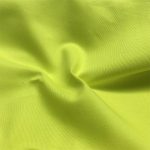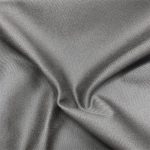1. Cotton
- Composition: 100% Cotton
- Specification: Typically 150-300 GSM
- Applications: Ideal for general workwear, such as shirts, pants, and overalls. Commonly used in industries where comfort and breathability are essential, such as agriculture and light manufacturing.
Standard Tests
1) Tensile Strength
- Method: ASTM D5034 or ISO 13934-1
- Description: A sample of the fabric is clamped in a testing machine and pulled apart at a constant rate until it breaks. The force required to break the fabric is measured.
- Purpose: Ensures the fabric can withstand pulling forces during use.
2) Shrinkage
- Method: AATCC TM135 or ISO 5077
- Description: Fabric samples are washed and dried under controlled conditions. The dimensions are measured before and after to calculate shrinkage percentage.
- Purpose: Measures the fabric’s dimensional stability after washing.
3) Color Fastness
- Method: AATCC TM61 or ISO 105-C10
- Description: Fabric samples are subjected to washing, rubbing, and light exposure. The color change is assessed using a grey scale.
- Purpose: Assesses the fabric’s resistance to fading under various conditions.
2. Polyester/Cotton Blends
- Composition: Typically 65% Polyester and 35% Cotton (80% Poly 20% Cotton OR 60% Cotton 40% Polyester)
- Specification: Ranges from 180-300 GSM
- Applications: Used for uniforms, work shirts, and trousers in a variety of industries, including construction, manufacturing, and logistics. The blend provides a balance of comfort, durability, and ease of care.
Standard Tests
1) Tear Strength
- Method: ASTM D1424 or ISO 13937-2
- Description: A sample is cut with a notch and torn apart. The force required to continue the tear is measured.
- Purpose: Ensures the fabric can resist tearing under stress.
2) Abrasion Resistance
- Method: ASTM D4966 or ISO 12947-2
- Description: A sample is rubbed against a standard abrasive surface until it shows wear. The number of cycles to reach a specified end point is recorded.
- Purpose: Measures the fabric’s ability to withstand surface wear.
3) Pilling Resistance
- Method: ASTM D4970 or ISO 12945-2
- Description: Fabric samples are subjected to controlled rubbing. The formation of pills (small balls of fiber) is evaluated.
- Purpose: Assesses the fabric’s tendency to form pills during use.
3. Cotton Spandex Fabric
- Composition: Typically 97% Cotton and 3% Spandex
- Specification: Usually 180-300 GSM
- Applications: Used in workwear that requires flexibility and comfort, such as uniforms, pants, and shirts. Commonly used in industries that involve a lot of movement, such as construction, logistics, and maintenance.
Standard Tests
1) Tensile Strength
- Method: ASTM D5034 or ISO 13934-1
- Description: A sample of the fabric is clamped in a testing machine and pulled apart at a constant rate until it breaks. The force required to break the fabric is measured.
- Purpose: Make sure the fabric can withstand pulling forces during use.
2) Shrinkage
- Method: AATCC TM135 or ISO 5077
- Description: Fabric samples are washed and dried under controlled conditions. The dimensions are measured before and after to calculate shrinkage percentage.
- Purpose: Measure the fabric’s dimensional stability after washing.
3) Color Fastness
- Method: AATCC TM61 or ISO 105-C10
- Description: Fabric samples are subjected to washing, rubbing, and light exposure. The color change is assessed using a grey scale.
- Purpose: Assess the fabric’s resistance to fading under various conditions.
4) Pilling Resistance
- Method: ASTM D4970 or ISO 12945-2
- Description: Fabric samples are subjected to controlled rubbing. The formation of pills (small balls of fiber) is evaluated.
- Purpose: Assess the fabric’s tendency to form pills during use.
5) Abrasion Resistance
- Method: ASTM D4966 or ISO 12947-2
- Description: A sample is rubbed against a standard abrasive surface until it shows wear. The number of cycles to reach a specified end point is recorded.
- Purpose: Measure the fabric’s ability to withstand surface wear.
4. Flame Retardant Fabrics
- Composition: Can be Cotton treated with flame retardant chemicals or inherent flame-resistant fibers such as Aramid (100% Cotton OR 88/12 Cotton/Nylon)
- Specification: Typically 200-400 GSM
- Applications: Essential in industries such as firefighting, welding, and electrical work. These fabrics provide protection against flash fires and electrical arcs.
Standard Tests
1) Vertical Flammability Test
- Method: ASTM D6413 or ISO 15025
- Description: Fabric samples are exposed to a vertical flame for a specified duration. The after-flame and after-glow times are recorded, along with any damage.
- Purpose: Measure the fabric’s ability to self-extinguish after being exposed to flame.
2) Thermal Shrinkage Resistance
- Method: ISO 17493
- Description: Fabric samples are exposed to high temperatures, and the dimensional changes are measured.
- Purpose: Assess the fabric’s stability at high temperatures.
3) Arc Flash Protection
- Method: ASTM F1959 or IEC 61482-1-1
- Description: Fabric samples are exposed to an electric arc, and the energy required to cause ignition is measured.
- Purpose: Evaluate the fabric’s ability to protect against electrical arc hazards.
5. High-Visibility Fabrics
- Composition: Typically Polyester, Polyester/Cotton blends, or Polyester/Aramid blends
- Specification: Usually 150-250 GSM
- Applications: Used in safety vests, jackets, and pants to ensure visibility in low-light conditions. Commonly used by road workers, airport ground crews, and emergency responders.
Standard Tests
1) Color Fastness to Light
- Method: AATCC TM16 or ISO 105-B02
- Description: Fabric samples are exposed to artificial light that simulates sunlight. The extent of fading is measured.
- Purpose: Make sure the fabric maintains its high-visibility properties over time.
2) Retro-reflective Performance
- Method: EN 471 /EN20471 or ANSI/ISEA 107
- Description: Reflective strips on the fabric are tested for their ability to reflect light back to its source.
- Purpose: Measure the fabric’s ability to enhance visibility in low-light conditions.
3) Tear Resistance
- Method: ASTM D1424 or ISO 13937-2
- Description: A sample is cut with a notch and torn apart. The force required to continue the tear is measured.
- Purpose: Assess the fabric’s durability against tearing forces.
Conclusion
Choosing the right fabric for workwear is crucial for ensuring the safety, comfort, and efficiency of workers across various industries. Each type of fabric offers unique properties that make it suitable for specific applications, from the breathability of cotton to the durability of polyester and the protective qualities of flame-retardant materials. At Hubei Jiezhixin Textiles, we specialize in manufacturing high-quality industrial workwear fabrics that meet stringent industry standards, ensuring that our products provide the best protection and performance for your workforce.

 100% COTTON FABRIC
100% COTTON FABRIC COTTON STRETCH FABRIC
COTTON STRETCH FABRIC POLYESTER/COTTON FABRIC
POLYESTER/COTTON FABRIC OTHERS FABRIC
OTHERS FABRIC